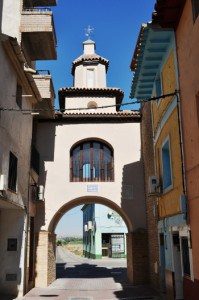Pincha en «play» para escuchar el audio.
 Portal de san Antón. Siglo XVIII.
Portal de san Antón. Siglo XVIII.
El portal de San Antón se presenta como un bello conjunto homogéneo, en el que se distinguen tres volúmenes de ladrillo encalado que le confieren un marcado carácter popular.
Un arco de medio punto da paso bajo el portal, comunicando el recinto urbano con la huerta a orillas del Ebro. Sobre el primer cuerpo se levanta el cuerpo principal, en el cual se sitúa la capilla, de planta cuadrada y cubierta con cúpula que se traduce en el exterior en volumen cuadrado menor.
Todo el conjunto se corona con linterna para la ubicación de la campana. En el centro del cuerpo principal recientemente se ha abierto una hornacina saliente en la que se puede contemplar al santo protector desde la calle. Al igual que los otros portales, en 2010 sufrió una reforma que permite disfrutarlo en su estado original.
Cada 16 de enero por la noche se celebra la víspera de san Antón, quemando una gran hoguera y merendando en torno a ella.
 The gate dedicated to St Anthony the Great stands as a beautiful uniform piece, in which we can appreciate three sections of whitewashed brick that give a strong popular aspect.
The gate dedicated to St Anthony the Great stands as a beautiful uniform piece, in which we can appreciate three sections of whitewashed brick that give a strong popular aspect.
A semi-circular arch allows the way under the gate, connecting the urban enclosure to the orchard beside the river Ebro banks. Over the first level stands the main level (in which the chapel is located), square based and covered by a cupola that at the outside turns into a smaller square shape.
The building is topped by a lantern, where the bell is located. In the centre of the main floor a projecting niche has recently been open and it allows seeing the saint from the street. Just like the other gates, it was renovated in 2010 and nowadays we can enjoy its original state.
St Anthony the Great’s eve is celebrated on the evening of January 16, burning a large bonfire and eating around it.




 Ecomputer S.L.
Ecomputer S.L.